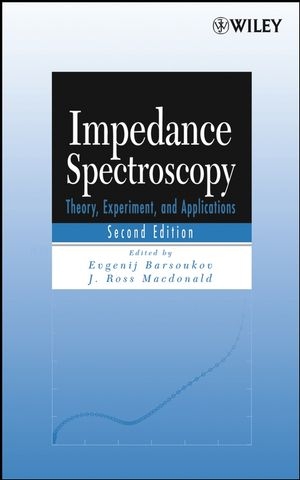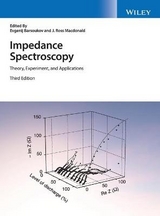
Impedance Spectroscopy
John Wiley & Sons Inc (Verlag)
978-0-471-64749-2 (ISBN)
- Titel erscheint in neuer Auflage
- Artikel merken
Backed by a team of expert contributors, the Second Edition of this highly acclaimed publication brings a solid understanding of impedance spectroscopy to students, researchers, and engineers in physical chemistry, electrochemistry, and physics. Starting with general principles, the book moves on to explain in detail practical applications for the characterization of materials in electrochemistry, semiconductors, solid electrolytes, corrosion, solid–state devices, and electrochemical power sources. The book covers all of the topics needed to help readers identify whether impedance spectroscopy may be an appropriate method for their particular research problem.
The book helps readers quickly grasp how to apply their new knowledge of impedance spectroscopy methods to their own research problems through the use of unique features such as:
∗ Step–by–step instructions for setting up experiments and then analyzing the results
∗ Theoretical considerations for dealing with modeling, equivalent circuits, and equations in the complex domain
∗ Best measurement methods for particular systems and alerts to potential sources of errors
∗ Equations for the most widely used impedance models
∗ Figures depicting impedance spectra of typical materials and devices
∗ Extensive references to the scientific literature for more information on particular topics and current research
This Second Edition incorporates the results of the last two decades of research on the theories and applications of impedance spectroscopy. Most notably, it includes new chapters on batteries, supercapacitors, fuel cells, and photochromic materials. A new chapter on commercially available measurement systems reflects the emergence of impedance spectroscopy as a mainstream research tool.
With its balanced focus on both theory and practical problem solving, Impedance Spectroscopy: Theory, Experiment, and Applications, Second Edition serves as an excellent graduate–level textbook as well as a hands–on guide and reference for researchers and engineers.
EVGENIJ BARSOUKOV, PhD, is a Senior Application Engineer at Texas Instruments, Inc. His current research focuses on the application of impedance spectroscopy based modeling to improve battery monitoring technology. J. ROSS MACDONALD, DSc, is the William Rand Kenan, Jr., Professor Emeritus of Physics at The University of North Carolina. He has published more than 200 papers in the fields of physics, chemistry, applied mathematics, and electrical engineering, and he was the editor of the First Edition of Impedance Spectroscopy (Wiley). His current research uses impedance spectroscopy to help analyze the electrical response of high–resistivity ionically conducting solid materials.
Preface.
Preface to the First Edition.
Contributors.
Contributors to the First Edition.
Chapter 1. Fundamentals of Impedance Spectroscopy (J.Ross Macdonald and William B. Johnson).
1.1. Background, Basic Definitions, and History.
1.1.1 The Importance of Interfaces.
1.1.2 The Basic Impedance Spectroscopy Experiment.
1.1.3 Response to a Small–Signal Stimulus in the Frequency Domain.
1.1.4 Impedance–Related Functions.
1.1.5 Early History.
1.2. Advantages and Limitations.
1.2.1 Differences Between Solid State and Aqueous Electrochemistry.
1.3. Elementary Analysis of Impedance Spectra.
1.3.1 Physical Models for Equivalent Circuit Elements.
1.3.2 Simple RC Circuits.
1.3.3 Analysis of Single Impedance Arcs.
1.4. Selected Applications of IS.
Chapter 2. Theory (Ian D. Raistrick, Donald R. Franceschetti, and J. Ross Macdonald).
2.1. The Electrical Analogs of Physical and Chemical Processes.
2.1.1 Introduction.
2.1.2 The Electrical Properties of Bulk Homogeneous Phases.
2.1.2.1 Introduction.
2.1.2.2 Dielectric Relaxation in Materials with a Single Time Constant.
2.1.2.3 Distributions of Relaxation Times.
2.1.2.4 Conductivity and Diffusion in Electrolytes.
2.1.2.5 Conductivity and Diffusion a Statistical Description.
2.1.2.6 Migration in the Absence of Concentration Gradients.
2.1.2.7 Transport in Disordered Media.
2.1.3 Mass and Charge Transport in the Presence of Concentration Gradients.
2.1.3.1 Diffusion.
2.1.3.2 Mixed Electronic Ionic Conductors.
2.1.3.3 Concentration Polarization.
2.1.4 Interfaces and Boundary Conditions.
2.1.4.1 Reversible and Irreversible Interfaces.
2.1.4.2 Polarizable Electrodes.
2.1.4.3 Adsorption at the Electrode Electrolyte Interface.
2.1.4.4 Charge Transfer at the Electrode Electrolyte Interface.
2.1.5 Grain Boundary Effects.
2.1.6 Current Distribution, Porous and Rough Electrodes the Effect of Geometry.
2.1.6.1 Current Distribution Problems.
2.1.6.2 Rough and Porous Electrodes.
2.2. Physical and Electrochemical Models.
2.2.1 The Modeling of Electrochemical Systems.
2.2.2 Equivalent Circuits.
2.2.2.1 Unification of Immitance Responses.
2.2.2.2 Distributed Circuit Elements.
2.2.2.3 Ambiguous Circuits.
2.2.3 Modeling Results.
2.2.3.1 Introduction.
2.2.3.2 Supported Situations.
2.2.3.3 Unsupported Situations: Theoretical Models.
2.2.3.4 Unsupported Situations: Equivalent Network Models.
2.2.3.5 Unsupported Situations: Empirical and Semiempirical Models.
Chapter 3. Measuring Techniques and Data Analysis.
3.1. Impedance Measurement Techniques (Michael C. H. McKubre and Digby D. Macdonald).
3.1.1 Introduction.
3.1.2 Frequency Domain Methods.
3.1.2.1 Audio Frequency Bridges.
3.1.2.2 Transformer Ratio Arm Bridges.
3.1.2.3 Berberian Cole Bridge.
3.1.2.4 Considerations of Potentiostatic Control.
3.1.2.5 Oscilloscopic Methods for Direct Measurement.
3.1.2.6 Phase–Sensitive Detection for Direct Measurement.
3.1.2.7 Automated Frequency Response Analysis.
3.1.2.8 Automated Impedance Analyzers.
3.1.2.9 The Use of Kramers Kronig Transforms.
3.1.2.10 Spectrum Analyzers.
3.1.3 Time Domain Methods.
3.1.3.1 Introduction.
3.1.3.2 Analog–to–Digital (A/D) Conversion.
3.1.3.3 Computer Interfacing.
3.1.3.4 Digital Signal Processing.
3.1.4 Conclusions.
3.2. Commercially Available Impedance Measurement Systems (Brian Sayers).
3.2.1 Electrochemical Impedance Measurement Systems.
3.2.1.1 System Configuration.
3.2.1.2 Why Use a Potentiostat?
3.2.1.3 Measurements Using 2, 3 or 4–Terminal Techniques.
3.2.1.4 Measurement Resolution and Accuracy.
3.2.1.5 Single Sine and FFT Measurement Techniques.
3.2.1.6 Multielectrode Techniques.
3.2.1.7 Effects of Connections and Input Impedance.
3.2.1.8 Verification of Measurement Performance.
3.2.1.9 Floating Measurement Techniques.
3.2.1.10 Multichannel Techniques.
3.2.2 Materials Impedance Measurement Systems.
3.2.2.1 System Configuration.
3.2.2.2 Measurement of Low Impedance Materials.
3.2.2.3 Measurement of High Impedance Materials.
3.2.2.4 Reference Techniques.
3.2.2.5 Normalization Techniques.
3.2.2.6 High Voltage Measurement Techniques.
3.2.2.7 Temperature Control.
3.2.2.8 Sample Holder Considerations.
3.3. Data Analysis (J. Ross Macdonald).
3.3.1 Data Presentation and Adjustment.
3.3.1.1 Previous Approaches.
3.3.1.2 Three–Dimensional Perspective Plotting.
3.3.1.3 Treatment of Anomalies.
3.3.2 Data Analysis Methods.
3.3.2.1 Simple Methods.
3.3.2.2 Complex Nonlinear Least Squares.
3.3.2.3 Weighting.
3.3.2.4 Which Impedance–Related Function to Fit?
3.3.2.5 The Question of What to Fit Revisited.
3.3.2.6 Deconvolution Approaches.
3.3.2.7 Examples of CNLS Fitting.
3.3.2.8 Summary and Simple Characterization Example.
Chapter 4. Applications of Impedance Spectroscopy.
4.1. Characterization of Materials (N. Bonanos, B. C. H. Steele, and E. P. Butler).
4.1.1 Microstructural Models for Impedance Spectra of Materials.
4.1.1.1 Introduction.
4.1.1.2 Layer Models.
4.1.1.3 Effective Medium Models.
4.1.1.4 Modeling of Composite Electrodes.
4.1.2 Experimental Techniques.
4.1.2.1 Introduction.
4.1.2.2 Measurement Systems.
4.1.2.3 Sample Preparation Electrodes.
4.1.2.4 Problems Associated With the Measurement of Electrode Properties.
4.1.3 Interpretation of the Impedance Spectra of Ionic Conductors and Interfaces.
4.1.3.1 Introduction.
4.1.3.2 Characterization of Grain Boundaries by IS.
4.1.3.3 Characterization of Two–Phase Dispersions by IS.
4.1.3.4 Impedance Spectra of Unusual Two–phase Systems.
4.1.3.5 Impedance Spectra of Composite Electrodes.
4.1.3.6 Closing Remarks.
4.2. Characterization of the Electrical Response of High Resistivity Ionic and Dielectric Solid Materials by Immittance Spectroscopy (J. Ross Macdonald).
4.2.1 Introduction.
4.2.2 Types of Dispersive Response Models: Strengths and Weaknesses.
4.2.2.1 Overview.
4.2.2.2 Variable–slope Models.
4.2.2.3 Composite Models.
4.2.3 Illustration of Typical Data Fitting Results for an Ionic Conductor.
4.3. Solid State Devices (William B. Johnson and Wayne L. Worrell).
4.3.1 Electrolyte Insulator Semiconductor (EIS) Sensors.
4.3.2 Solid Electrolyte Chemical Sensors.
4.3.3 Photoelectrochemical Solar Cells.
4.3.4 Impedance Response of Electrochromic Materials and Devices (Gunnar A. Niklasson, Anna Karin Johsson, and Maria Strømme).
4.3.4.1 Introduction.
4.3.4.2 Materials.
4.3.4.3 Experimental Techniques.
4.3.4.4 Experimental Results on Single Materials.
4.3.4.5 Experimental Results on Electrochromic Devices.
4.3.4.6 Conclusions and Outlook.
4.3.5 Time–Resolved Photocurrent Generation (Albert Goossens).
4.3.5.1 Introduction Semiconductors.
4.3.5.2 Steady–State Photocurrents.
4.3.5.3 Time–of–Flight.
4.3.5.4 Intensity–Modulated Photocurrent Spectroscopy.
4.3.5.5 Final Remarks.
4.4. Corrosion of Materials (Digby D. Macdonald and Michael C. H. McKubre).
4.4.1 Introduction.
4.4.2 Fundamentals.
4.4.3 Measurement of Corrosion Rate.
4.4.4 Harmonic Analysis.
4.4.5 Kramer Kronig Transforms.
4.4.6 Corrosion Mechanisms.
4.4.6.1 Active Dissolution.
4.4.6.2 Active Passive Transition.
4.4.6.3 The Passive State.
4.4.7 Point Defect Model of the Passive State (Digby D. Macdonald).
4.4.7.1 Introduction.
4.4.7.2 Point Defect Model.
4.4.7.3 Electrochemical Impedance Spectroscopy.
4.4.7.4 Bilayer Passive Films.
4.4.8 Equivalent Circuit Analysis (Digby D. Macdonald and Michael C. H. McKubre).
4.4.8.1 Coatings.
4.4.9 Other Impedance Techniques.
4.4.9.1 Electrochemical Hydrodynamic Impedance (EHI).
4.4.9.2 Fracture Transfer Function (FTF).
4.4.9.3 Electrochemical Mechanical Impedance.
4.5. Electrochemical Power Sources.
4.5.1 Special Aspects of Impedance Modeling of Power Sources (Evgenij Barsoukov).
4.5.1.1 Intrinsic Relation Between Impedance Properties and Power Sources Performance.
4.5.1.2 Linear Time–Domain Modeling Based on Impedance Models, Laplace Transform.
4.5.1.3 Expressing Model Parameters in Electrical Terms, Limiting Resistances and Capacitances of Distributed Elements.
4.5.1.4 Discretization of Distributed Elements, Augmenting Equivalent Circuits.
4.5.1.5 Nonlinear Time–Domain Modeling of Power Sources Based on Impedance Models.
4.5.1.6 Special Kinds of Impedance Measurement Possible with Power Sources Passive Load Excitation and Load Interrupt.
4.5.2 Batteries (Evgenij Barsoukov).
4.5.2.1 Generic Approach to Battery Impedance Modeling.
4.5.2.2 Lead Acid Batteries.
4.5.2.3 Nickel Cadmium Batteries.
4.5.2.4 Nickel Metal–hydride Batteries.
4.5.2.5 Li–ion Batteries.
4.5.3 Impedance Behavior of Electrochemical Supercapacitors and Porous Electrodes (Brian E. Conway).
4.5.3.1 Introduction.
4.5.3.2 The Time Factor in Capacitance Charge or Discharge.
4.5.3.3 Nyquist (or Argand) Complex–Plane Plots for Representation of Impedance Behavior.
4.5.3.4 Bode Plots of Impedance Parameters for Capacitors.
4.5.3.5 Hierarchy of Equivalent Circuits and Representation of Electrochemical Capacitor Behavior.
4.5.3.6 Impedance and Voltammetry Behavior of Brush Electrode Models of Porous Electrodes.
4.5.3.7 Impedance Behavior of Supercapacitors Based on Pseudocapacitance.
4.5.3.8 Deviations of Double–layer Capacitance from Ideal Behavior: Representation by a Constant–phase Element (CPE).
4.5.4 Fuel Cells (Norbert Wagner).
4.5.4.1 Introduction.
4.5.4.2 Alkaline Fuel Cells (AFC).
4.5.4.3 Polymer Electrolyte Fuel Cells (PEFC).
4.5.4.4 Solid Oxide Fuel Cells (SOFC).
Appendix. Abbreviations and Definitions of Models.
References.
Index.
| Erscheint lt. Verlag | 8.4.2005 |
|---|---|
| Reihe/Serie | Wiley-Interscience |
| Verlagsort | New York |
| Sprache | englisch |
| Maße | 160 x 239 mm |
| Gewicht | 988 g |
| Themenwelt | Naturwissenschaften ► Chemie |
| ISBN-10 | 0-471-64749-7 / 0471647497 |
| ISBN-13 | 978-0-471-64749-2 / 9780471647492 |
| Zustand | Neuware |
| Informationen gemäß Produktsicherheitsverordnung (GPSR) | |
| Haben Sie eine Frage zum Produkt? |
aus dem Bereich



